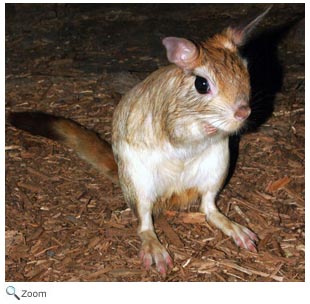Pedetidae - spring hare
 There are two species in this family, the spring hare and the east African spring hare. Spring hares are found in southern Africa in dry, open savannas that are free of rocks and bushes. There are two species in this family, the spring hare and the east African spring hare. Spring hares are found in southern Africa in dry, open savannas that are free of rocks and bushes.
What might you get if you crossed a kangaroo with a rabbit? It might be a spring hare.
Spring hares look like mini kangaroos! They are about 17 inches in length and have small front legs; large rear legs with long feet; large, rabbit-like ears; a long bushy tail; and big, round eyes. They have flaps on their ears that they can close to keep sand out! Spring hares use their long back legs to leap distances of 20-30 feet! They use the sharp claws on their front legs for digging their burrows.
Spring hares are nocturnal and live in burrows. They are herbivores and eat roots, stems, and fruit. They usually don't travel more that a few hundred yards from their burrow in search of food. World Status Key
 Least Concern Least Concern  Near Threatened Near Threatened  Vulnerable Vulnerable  Endangered Endangered  Critically Endangered Critically Endangered  Extinct in Wild Extinct in Wild  Extinct Extinct
Status and range is taken from ICUN Redlist. If no status is listed, there is not enough data to establish status.
US Status Key
 Threatened in US Threatened in US  Threatened in NH Threatened in NH  Endangered in US Endangered in US  Endangered in NH Endangered in NH  Breeds N.H. Breeds N.H.  Introduced Introduced
Status taken from US Fish and Wildlife and NH Fish and Game
New Hampshire Species |
|
North/Central American Species |
None
|
|
None |
Additional Information
Key:  Profile Profile  Photos Photos  Video Video  Audio Audio
Spring Hare - Pedetes capensis    
Spring hares are usually silent animals, but they will grunt when they are excited and make a bleating noise when they are in danger.
Source: African Wildlife Foundation Intended Audience: General Reading Level: Middle School Teacher Section: No
Spring Hare - Pedetes capensis    
The spring hare sometimes leaves its burrows with a huge leap into the air. It may do this to avoid any predators that might be waiting for it.
Source: EDGE Intended Audience: General Reading Level: Middle School Teacher Section: Yes |

